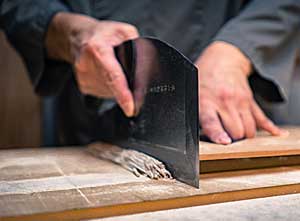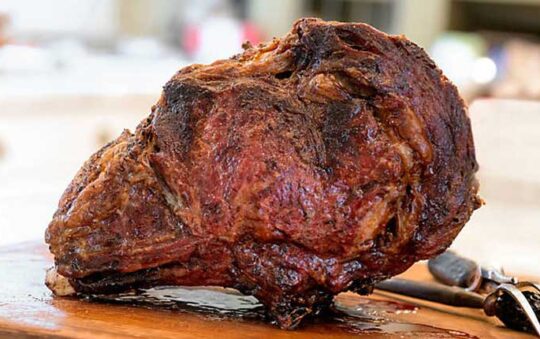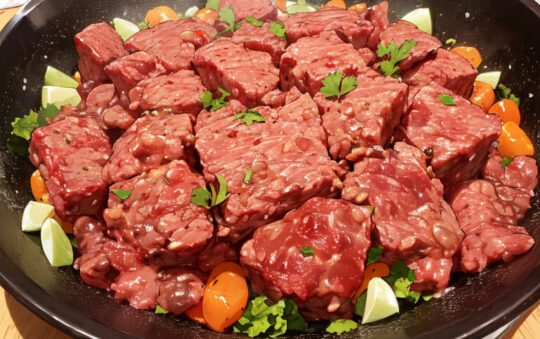
There’s no question that high quality cutlery is an essential component of any kitchen, especially if you really enjoy cooking. It is important that you are able to prepare meals as easily and efficiently as possible. This will ultimately help save you a lot of time and frustration over the years.
Chances are you have asked yourself why are japanese knives so good at some point. In this article we will take an in-depth look at these types of knives so that you can make an informed decision. We highly recommend that you take the time to read the following information.
Unique Characteristics of Japanese Knives
You will find that there are a number of unique characteristics that set Japanese knives apart from traditional western cutlery. These knives have been around a very long time, and for good reason. If you want to know why are japanese knives so good, we encourage you to keep reading.
Japanese knives are typically much lighter than other knives, and they offer a nice balanced overall feel in your hand. This makes them easier to hold and use properly.
Another thing that sets these knives apart from so many others is their durable and long lasting construction. The blades consist of numerous layers, including carbon steel and iron steel. These materials are corrosion-resistant and will easily last for many years of regular use.
These knives tend to offer remarkable sharpness over a long period of time. They don’t become dull quickly like so many other knives on the market. This is just one of the reasons that they are used by chefs in some of the best restaurants all over the world.
Types of Japanese Knives
Before you decide to go ahead and purchase a set of Japanese knives, it is important to explore your options. There are two primary types—hybrid and single-edged. Each one offers a number of benefits and can serves a multitude of purposes in the kitchen.
Petty
Petty knives measure anywhere from four to six inches long on average. They are ideal for precision cutting, such as with chopping up smaller fruits or vegetables. You’ll find that they are also very useful when cutting various herbs.
Gyutou
Measuring between 7 and 10 inches, Gyutou knives are extremely versatile as a whole. You can use them for cutting meat, vegetables, fruits, and much more. This is an excellent place to start if you are interested in purchasing Japanese knives for home use.
Sujihiki
The Sujihiki knife is specifically designed for slicing. It is therefore an excellent choice when carving up different types of roasts. You can also use them for cutting fish when making sushi and other seafood dishes.
Honesuki
A honesuki knife can be immensely useful when it comes to cutting up a chicken. If you need to butcher a small animal carcass, this is definitely one of the best types of knives you can find.
Santoku
Santoku knives measure 6 to 7 inches long and can be used for a number of different tasks. This is another incredibly versatile knife that is well-suited to chopping, slicing, mincing, and a lot more.
Nakiri
Nakiri knives are equivalent to the butcher’s knife. The blade has a square shape and is perfect for chopping up vegetables. You’ll have a very easy time making even cuts on a consistent basis.
Benefits of Using Japanese Knives
Next, we will take a look at the main benefits of owning these knives. If you want to know why are japanese knives so good, we recommend considering the following things:
• Sharpness: Japanese knives have a long lasting reputation for their unbelievable sharpness. This will go a long way towards helping you with food prep in the kitchen on a regular basis.
• Longevity: You can rely on these knives to stand the test of time. They can easily last for many decades with little to no maintenance.
• Variety: As we discussed above, there are lots of different Japanese knives to choose from. You should therefore be able to find whatever you need fairly easily.
• Precision: Many of these knives are specifically designed for precise cutting, which can be extremely beneficial.
• Ergonomic design: You’ll find that most Japanese knives offer comfortable overall handling. This is very important when it comes to making your job in the kitchen easier than ever.
Things to Consider When Buying Japanese Knives

Many people wonder why are japanese knives so good, but they don’t take the time to find the right ones. It is crucial that you consider the following criteria before making a final decision.
Construction
Make sure that the knives you buy are truly built to last. We recommend ones that feature a hagane blade, which is amazingly tough overall. It is also incredibly flexible and resistant to warping. While many people think that stainless steel makes for the best knives, it doesn’t hold a candle to this material.
Handle design
You should also make a point of choosing knives that have a superb handle design. They should offer a comfortable and secure grip with no risk of slipping.
Weight
A lot of people don’t even consider the weight of the knives they purchase. This can have a significant impact on your ability to use them for extended periods. Look for knives that are relatively lightweight.
Length
The length of the blade that you purchase will ultimately determine its potential uses. It is a good idea to consider what you need the knife for when examining your options. You should also consider the size of your hands, as this will affect how comfortable each knife will be.
Final Thoughts
The fact is that Japanese knives are vastly superior to most western cutlery in almost every way. While you might need to spend a bit more on these knives, it is well worth the additional expense.
They will serve you well in your kitchen for many years to come. Take the time to look for ones that are sturdy and designed to match your specific needs. Whether you are making sushi or cutting up a chicken, it is important to select the right knife.
Now you know how to pick the right Japanese knife for your kitchen. But what about the cutting board? If you ever wonder how to choose the right cutting board for your Japanese knife, check out our review article on the best cutting board for Japanese knives.





